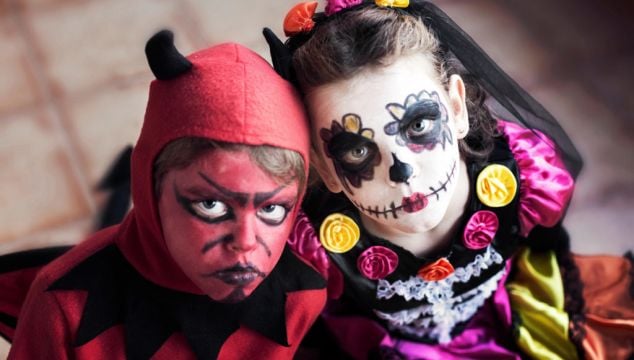From Kim Kardashian’s ill-named ‘kimono’ clothing line to Justin Bieber’s short-lived dreadlocks, several celebrities have been accused of cultural appropriation at one time or another.
While some stars are trying to show solidarity, such as Adele when she wore Bantu knots in her hair in 2021 to mark what would have been the Notting Hill Carnival, these attempts can go disastrously wrong.
If celebs can make mistakes, there’s a chance that you could be doing something unacceptable too when choosing a Halloween costume for yourself or your family.
View this post on InstagramAdvertisement
So, what is cultural appropriation and how can we avoid it?
Dr Sandrine Han, an independent researcher in cultural studies and visual culture in British Columbia, defines it as “using elements of a culture you don’t belong to or appreciate. If you go into a shop, you can easily find examples of it, with objects used in the wrong way or trivialised”.
One of the most common forms of cultural appropriation, and one we should be mindful of when choosing our Halloween outfits, is clothing identifiable to a specific group.
“Here in Canada, many people like to use indigenous costumes,” Han explains, “but people don’t understand what they’re wearing and why. There’s a meaning to everything, and [fancy dress outfits] are put together in the wrong way. You don’t understand or respect the elements and culture at hand.”
It’s not just about clothes. Appropriating elements of another race or culture can also signal privilege, which is problematic when we’re striving for equality.
Caryn Franklin, fashion and identity commentator and co-author of Skewed: Decoding Media Bias, explains: “When everyone chooses to behave in a culturally competent manner, we all benefit. [If you’re white] unpicking our white, heterosexual, cis-gender privilege to acknowledge how dominant culture has shaped our ideas about who is important or relevant, and who is seen and listened to, is one way of holding ourselves accountable.”
The fashion industry, for instance, “has made a habit of ignorant practice, sending white models up the runway in garments as varied as the Sikh turban by Gucci, a Native American headdress by Victoria’s Secret and false dreadlocks by Marc Jacobs”, she says. “Designers are now rightfully boycotted for cultural disrespect.”
Cultural Appropriation is a real issue but its not what most people think it is.
Its not when some white boy wears cornrows.
Its when Kim K puts on Box braids and gets called a fashion innovator while black women are told that their hair is unprofessional— ShonuffKay (@ShoNuffKay37) July 11, 2022
Celebrities often use cultural elements as a way of courting attention.
Franklin points to Lady Gaga’s controversial decision to wear a burqa in 2013. “When pop stars play dress-up, they too must avoid disrespecting other cultures. Lady Gaga wore a variety of hijab face coverings and burqa-style garments. Then she sang a raunchy song – an insult given the important expression of modesty for Islamic wearers of these meaningful clothes.”
So for those of us who aren’t celebrities, how can we avoid making their mistakes for dress-up events like Halloween?
Franklin says: “Ceremonial clothing that isn’t part of our culture, religious garb in general or anything that sexualises another’s cultural appearance – these are obvious no-nos.”
While Han advises: “Before you dress up or use another cultural element, stop and try and understand what you are doing, the significance of what you’re wearing. Make sure you’re respecting that culture. Appreciate it, don’t mock it.”
As a Native American, we are CONSTANTLY fighting the stereotypes of us and trying to get rid of native costumes. Red face and cultural appropriation HURT us. Please try to understand where we are coming from. It is a big issue that we still deal with to this day.
— justine (@headspces) September 9, 2022
It’s just as important to bear in mind when it comes to children’s Halloween costumes too.
“By all means enjoy your fancy dress frolics. But ask yourself: does the outfit you or your child is attracted to stereotype someone else’s culture or experience?” says Han. “And if we’re not sure, we can leave well alone and explain our choices to our children.”
Naturally, they might want to dress up as their favourite book, TV or film character, but some may be problematic – and it’s OK to say no.
“Perhaps tempted by the currency of a new raft of characters in our more diverse approach to storytelling, you and your children [may be] excited by personalities from cultures that are not your own. It’s understandable,” says Franklin.
“Parents dressing their white kids up as [Disney’s] Moana, which brings Polynesian culture to the big stage, or Raya [From Raya and the Last Dragon], drawing on south east Asian cultures, are stepping into a wider territory which requires recognition of the deep and ever present wounds of racism.”
Coco, from the 2017 Pixar film, is a popular costume for children but may be another problematic choice. “[The] movie centres on Día de los Muertos — the festive holiday celebrated in Mexico to honour the dead and features 12-year-old Miguel, an aspiring guitarist from a rural Mexican town,” says Franklin.
“The film provides stark evidence of the historical deficit of recognition and empathy for non-white lives and their struggles. One could say the dominant culture – and yes, if we are white that means us – is only just getting to grips with this dearth of representation and the far-reaching race inequalities behind it.”
Therefore, parents – “if it’s not our culture, and we wish to avoid inflicting further hurt, let’s leave well alone and explain our choices to our children,” Franklin says. “In other words start talking and educating ourselves and our young people about cultural appropriation – and acknowledge and understand what’s involved before you adopt.”
Han concludes: “When curiosity and humility becomes our assumed position, no one need feel uncomfortable or defensive.”







